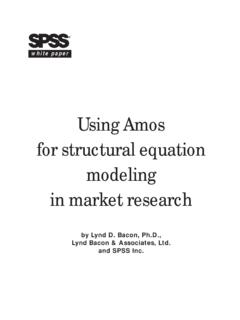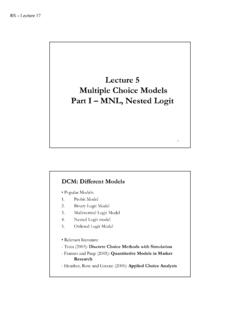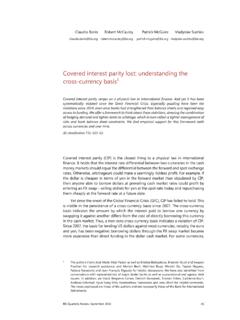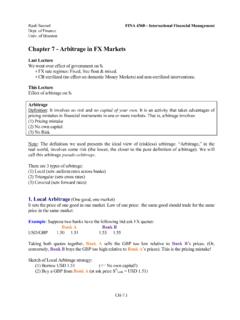Transcription of CHAPTER III EXCHANGE RATES, INTEREST RATES, PRICES …
1 CHAPTER III. EXCHANGE rates , INTEREST rates , PRICES AND EXPECTATIONS. This CHAPTER presents simple models of EXCHANGE rate determination. These models apply arbitrage arguments in different contexts to obtain equilibrium relations that determine EXCHANGE rates . In this CHAPTER , we define arbitrage as the activity that takes advantages of pricing mistakes in financial instruments in one or more markets, facing no risk and using no own capital. The no own capital requirement is usually met by buying and selling (or borrowing and lending) the same or equivalent assets or commodities. The no risk requirement is usually met by doing the buying and selling (or borrowing and lending) simultaneously. Obviously, arbitrageurs will engage in this activity only if it is profitable, which means there should be a pricing mistake. Financial markets are said to be in equilibrium if no arbitrage opportunities exist. The equilibrium relations derived in this CHAPTER are called parity relations.
2 Because of the underlying arbitrage argument, parity relations establish situations where economic agents are indifferent between two financial alternatives. Thus, parity relations provide an equilibrium value or a benchmark. These benchmarks are very useful. For example, based on a parity benchmark, investors or policy makers can analyze if a foreign currency is overvalued or undervalued.. I. INTEREST Rate Parity Theorem (IRPT). The IRPT is a fundamental law of international finance. Open the pages of the Wall Street Journal and you will see that Argentine bonds yield 10% and Japanese bonds yield 1%. Why wouldn't capital flow to Argentina from Japan until this differential disappeared? Assuming that there are no government restrictions to the international flow of capital or transaction costs, the barrier that prevents Japanese capital to fly to Argentina is currency risk. Once yens are exchanged for pesos, there is no guarantee that the peso will not depreciate against the yen.
3 There is, however, one way to guarantee a conversion rate between the peso and the yen: a trader can use a forward foreign currency contract. Forward foreign currency contracts eliminate currency risk. A forward foreign currency contract allows a trader to compare domestic returns with foreign returns translated into the domestic currency, without facing currency risk. Arbitrage will ensure that both known returns, expressed in the same currency, are equal. That is, world INTEREST rates are linked together through the currency markets. The IRPT. embodies this relation: If the INTEREST rate on a foreign currency is different from that of the domestic currency, the forward EXCHANGE rate will have to trade away from the spot EXCHANGE rate by a sufficient amount to make profitable arbitrage impossible. Covered INTEREST arbitrage Covered INTEREST arbitrage is the activity that forces the IRPT to hold. Assume that there are no barriers to the free movement of capital across international borders , there is perfect capital mobility.
4 Consider the following notation: id = domestic nominal risk-free INTEREST rate for T days. if = foreign nominal risk-free INTEREST rate for T days. St = time t spot rate (direct quote: units of domestic currency per unit of foreign currency). Ft,T = forward rate for delivery at date T, at time t. Now, consider the following strategy: (1) At time 0, we borrow from a foreign bank one unit of a foreign currency for T days. At time T, we should pay the foreign bank (1+if x T/360) units of the foreign currency. (2) At time 0, we EXCHANGE the unit of foreign currency for domestic currency, that is, we get S units of domestic currency. (3) At time 0, we deposit St units of domestic currency in a domestic bank for T days. At time T, we should receive from the domestic bank St(1+id x T/360) units of domestic currency. (4) At time 0, we also enter into a T-day forward contract to buy foreign (sell domestic currency) at a pre-specified EXCHANGE rate (Ft,T).
5 At time T, we EXCHANGE the St(1+id) units of domestic currency for foreign currency, using the pre-specified EXCHANGE rate in the forward contract. That is, we get St(1+id x T/360)/Ft,T. units of foreign currency. This strategy will not be profitable if at time T, what we receive in units of foreign currency is equal to what we have to pay in units of foreign currency. Since arbitrageurs will be searching for an opportunity to make a risk-free profit, arbitrage will ensure that St (1 + id * T/360)/Ft,T = (1 + if * T/360). Solving for Ft,T, we obtain the following expression for the IRPT: . , ( ).. The IRP theory, also called covered IRPT, as presented above was first clearly exposed by John Maynard Keynes (1923). Notes: Steps (2) and (4) simultaneously done produce a FX swap transaction! In this case, we buy the FC forward at Ft,T and go sell the FC at St. We can think of (Ft,T - St) as a profit from the FX swap.
6 We get the same IRPT equation if we start the covered strategy by (1) borrowing DC at id; (2) exchanging DC for FC at St; (3) depositing the FC at if; and (4) selling the FC. forward at Ft,T. If the forward rate is not set according to ( ), arbitrage will occur. If a bank trader quotes a forward rate that violates ( ), other traders, immediately, will take advantage of the arbitrage opportunity. How can a bank make sure that other banks do not profit from its forward quotes? The answer is very easy: use ( ) to price forward foreign currency contracts. Example : The IRPT at work. A Japanese company wants to calculate the one-year forward JPY/USD rate. With spot yen selling at 150 JPY/USD and the JPY annual INTEREST rate equal to 7% and the USD annual INTEREST rate equal to 9%, the one-year forward rate should be: . , ) = 150 = JPY/USD.. Now, suppose instead that the IRPT is violated. For example, Bertoni Bank is quoting the forward rate for delivery in one-year at time t at Ft,one-year=140 JPY/USD.
7 Arbitrageurs will use covered INTEREST arbitrage to take advantage of this situation. The forward rate, Ft,one-year=140 JPY/USD, is less than what the arbitrage-free valuation should be. That is, the forward JPY is currently overvalued. Therefore, an arbitrageur would like to take advantage of this overvaluation of the forward JPY. A covered INTEREST arbitrage strategy works as follows: (1) Borrow one USD from a bank for one year. (2) EXCHANGE the USD for JPY 150. (3) Deposit the JPY 150 in a Japanese bank for one year. (4) Sell JPY (Buy USD) forward to Bertoni Bank at the forward rate 140 JPY/USD. For example, a arbitrageur simultaneously does the following steps: 1) She borrows USD 1 for a year at 9% (and she will pay back USD at the end of the year). 2) She takes this USD 1 and buys JPY 150. 3) She lends the JPY 150 for a year at 7% (and she receives JPY at the end of the year). 4) Simultaneously, she buys a one year forward contract at the EXCHANGE rate of 140 JPY/USD.
8 Her cash flows at the end of the year: - She pays USD to close loan in Step 1. - She exchanges JPY for USD using the 140 JPY/USD forward rate, getting USD (= ). Graphically, t = Today t = 1 year Borrow 1 USD 9% USD USD (= ). Deposit JPY 150 7% JPY After one year, the arbitrageur will realize a risk-free profit of USD. 056 per USD borrowed. Arbitrageurs will take advantage of this situation. Bertoni Bank will soon realize its forward quote is not correct, because it will receive an unusually large number of sell JPY forward orders. Arbitrage of this type will ensure that Ft,one-year= JPY/USD.. We can manipulate ( ) to obtain a simpler expression for the IRPT. By dividing both sides of ( ) by St, we obtain: , .. Now, we subtract 1 from both sides, giving us: , , . 1 1 .. The above expression can be approximated by , ( ). Example : INTEREST differentials and the linear approximation. Go back to Example The USD/GBP spot rate is St= The 180-day USD/GBP forward rate is Ft,180= That is, the USD is expected to appreciate with respect to the GBP in the next months.
9 The forward price of the GBP appears to be decreasing at a rate of about .4% a year ( in 180. days). This suggests that the short-term risk-free annual INTEREST rate is about .4% lower in the than in the . The approximation in ( ) is quite accurate when id and if are small, usually lower than 10%. The above equation gives us a linear approximation to formula ( ): , St * 1 . The above formulae assume discrete compounding. We can also use the following continuous formulation: Ft,T = St exp[(id - if) * T/360]. IRPT: Remark IRPT is a mathematical relation. You can think of the forward rate as an identity linking INTEREST rate differentials and currency rates . The economic intuition of this mathematical relation is simple: the forward rate is the rate that eliminates an arbitrage profit.. IRPT: Assumptions Behind the covered arbitrage strategy -steps (1) to (4)-, we have implicitly assumed: (1) Funding is available.
10 That is, step (1) can be executed. (2) Free capital mobility. No barriers to international capital flow , step (2) and later (4). can be implemented. (3) No default/country risk. That is, steps (3) and (4) are safe. (4) Absence of significant frictions. Typical examples: transaction costs & taxes. Small transactions costs are OK, as long as they do not impede arbitrage. We are also implicitly assuming that the forward contract for the desired maturity T is available. This may not be true. In general, the forward market is liquid for short maturities (up to 1 year). For many currencies, say from emerging market, the forward market may be liquid for much shorter maturities (up to 30 days). The Forward Premium and the IRPT. Recall the definition of forward premium, p: , p= *. Using IRPT derived above, we get that the forward premium is a function of the INTEREST rate differential. , p= * .. If the domestic INTEREST rate is higher (lower) than the foreign INTEREST rates , the forward premium is positive and the foreign currency is called a premium currency.

















